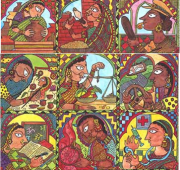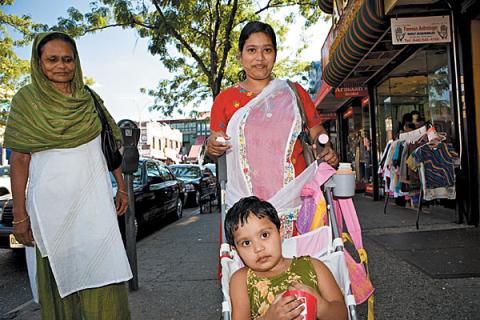From The Peopling of New York City
Jackson Heights: Microcosm of South Asian Women's Role in New York?
In Madhulika Khandelwal's reflection on Jackson Heights in Becoming American, Being Indian, Jackson Height's is portrayed as a "little India," commonly adopting an ethnic spelling: “Jai Kishan” Heights. Jackson Heights, with its endless sari shops, 14-Karat Jewelry stores, and South Asian restaurants, is said to be “reminiscent of South Hall in London or a shopping bazaar in India” (Khandewal 2002:26). However, when it comes down to the role played by South Asian women in American society, this little ethnic community fails to fully represent the various changes and growth that women have experience in New York. Jackson Heights is a business center that often portrays women through dress, jewelry, and Bollywood posters. These forms of portrayal tend to fantasize and stereotype South Asian females, depicting them in materialistic, delicate, and homemakers. Even the women who roam the streets are largely housewives.

They come with their families to pick up ethnic grocery products, or eat a meal. It is true that many women have held strong to more traditional female roles, as mothers and wives in a more patriarchal family. Furthermore, the depiction of South Asian fashion may also be seen as a representation of the female's culture, and it is definitely a way for a South Asian women to identify herself assertively. However, by simply looking at Jackson Heights, its shops, workers, and visitors, one fails to really understand the growth experienced by South Asian women in New York in the public and professional realms. The professional population of Jackson Heights, its doctor's and immigration lawyers, are all male. Furthermore, shops are owned largely by males, with females working as cashiers or sales clerks. Additionally, circulating local newspapers and letters often showcase parent's effors to marry off their young daughters. These values still exist amongst the South Asian community, therefore, it is important to use Jackson Heights as a foundation to explore South Asian women in America, for it offers some rich and interesting culture that can start to clarify how women perceive themselves and are perceived by others in New York. Today, being just a house wife is considered "old fashion." Economic and ideological pressures stress women to go into the workforce. Commonly, when migrating to America, a woman may need a job to help the economical status of the family. Additionally, in Indian and Pakistani immigrant culture, money is stressed and success usually means money, and of course family and health. Other women are driven through loneliness, while some wish to assert themselves as women and "follow their dreams" (Lessinger 1995:110-112).
